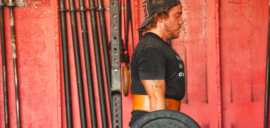
There is no doubt that we, as a population, have chronic dysfunction with regard to our ability to maintain spinal position. Low back issues are rampant, a very normal task like the deadlift still injures perfectly able-bodied individuals, and this might be propagated, in part, by social norms that lead us away from basic trunk stability.
What do I mean? I mean that many of us don’t understand the functional duty of the trunk muscles to stabilize the spine and transfer energy up and down the system. In addition to commonly not understanding this task, we’ve been conditioned, because of societal preferences, to move in dysfunctional ways.
Think about our obsession with abs. The term “abs” in the body image arena is like the word “protein” in the nutritional space. We’re obsessed. That being said, we’re constantly moving and bracing in ways that support what we think are the aesthetic standards of proper abdominals. Idealistic abs are flat and defined. As society understands them, they most literally aren’t pushed out, like a big belly.
Herein lies the problem. Proper stabilization of the spine is achieved with the simple ability to push out. The research coming out of Prague that’s been coined Dynamic Neuromuscular Stabilization (DNS) refers to this ability as intra-abdominal pressure. The has been extended extensively in BIRTHFIT‘s dialogue with their functional progression. In addition, the recent work by Julien Pineau emphasizes the contraction, and pushing out of the external obliques, which supports the same thing. All of these respective camps, however, are most definitely in agreement that functional trunk stability isn’t achieved by sucking in, which is what we do when we take pictures, want to appear aesthetically appealing, and even athletic. After all, this seems silly when we think about how a weight belt works. The belt works when you push out into it with your abdominal muscles. Sucking in, like a self-conscious beach goer, renders a weightlifting belt useless. Nonetheless, this is what some athletes, many who likely have chronic back issues, are doing to stabilize (dysfunctional as it may be) while training.
Awareness is the first step. Breaking this worldview that some people just can’t lift heavy without hurting their backs, for example, might be solved by proper bracing strategies. If you want to suck it in for your next photo, go for it, but when training you’ll likely be better off by doing the opposite.
Logan Gelbrich
@functionalcoach
8/1/17 WOD
1-1-1-1-1
Back Squat
Then, every 2 minutes for 16 minutes complete:
25 Russian KB Swings (53/35)
5 Burpees

